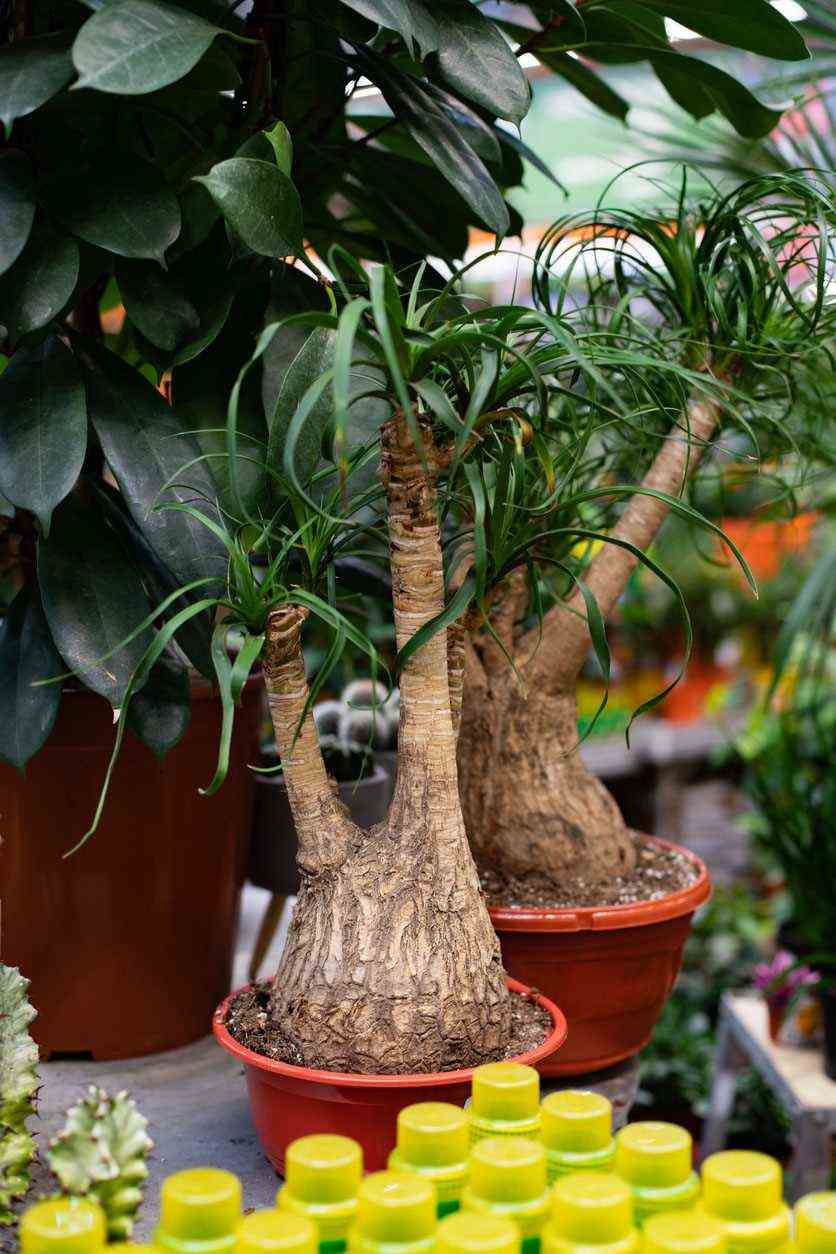Presentation of Beaucarnea
Fact sheet : | |
|---|---|
| Scientific name | Beaucarnea recurvata, Nolina recurvata, N. tuberculata |
| Family | |
| Other name | Elephant’s Foot, Bottle Tree, Curved Noline |
| Origin | Mexico |
| Dimensions | 1 to 2 meters indoors and up to 10 meters outdoors. |
| Flower color (s) | Beige |
| Leaf color (s) | Light greenDark green |
| Type of plant | Shrub plant |
| Vegetation | Perennial |
| Foliage in winter | Persistent |
| Flowering |
Jan.
Feb.
Mar.
Apr.
May
June
Jul.
August
Seven.
Oct.
Nov.
Dec. |
Culture sheet: | |
|---|---|
| Planting |
Jan.
Feb.
Mar.
Apr.
May
June
Jul.
August
Seven.
Oct.
Nov.
Dec. |
| Growth | Growth is slow. |
| Exposure | Sun, strong light indoors |
| Ground | Drained, Soil, Sandy, Heather |
| Humidity | Moderate |
| use | Pot, Bac, Isolated, Possible outside (in the south) |
| Multiplication | Semi, Rejects |
| Disease (s) and pest (s) | Mealybugs, Red Spider |
Elephant foot care
Resistant, Beaucarnea is easy to maintain and does not require a lot of care once it has found its place in your interior.
Beaucarnea is not a rustic plant. Used to tropical climates, it does not support a temperature lower than 5 ° C. This is the reason why, in our regions, it is only found indoors. It perfectly supports high temperatures and it can, moreover, be placed outside during the summer season. But it will be necessary to remember to bring it in as soon as the temperatures start to drop. In winter, it will appreciate being placed in a slightly less heated room, this will promote its dormant period.
In the southern regions, for example in the south, it can be grown outdoors throughout the year. It is still preferable to protect your plant with a wintering veil while it is still young.
If in nature it can reach 10 m high, there is no risk that this will happen in your interior where it will remain in the state of a shrub or its growth is very slow.

Watering Beaucarnea: frequency and period
Beaucarnea requires little water. It is more often an excessive watering which risks killing it. Indeed, Beaucarnea is better able to withstand a lack of water than an excess of water. In any case, before proceeding to a new watering, let the substrate dry. This way, you can be sure to bring water to your plant only when it needs it.
- During the period from March to October, a Beaucarnea should be watered about once a week.
- Then once a month in winter, because the plant is at rest, its water needs are reduced. In addition, in winter, it prefers a cool, dry atmosphere.
- For watering, prefer lukewarm water.
- To water it, wet the entire surface of the substrate, then, about 30 minutes later, remove all the water that is in the saucer. It is important not to let water stagnate, as this can cause the roots to rot.
- Spray the foliage on a regular basis.
- It is possible to add liquid fertilizer to the irrigation water once a month between April and October. In this case, think about stopping these additional contributions during the vegetative rest.
Land and ideal exposure for the cultivation of Beaucarnea
It originated in Mexico in semi-desert areas. Where it grows, the soil is neutral or even a little acidic, but in all cases, it is light and well drained.

For container culture, no need to recreate this substrate perfectly. He can be satisfied with a ordinary potting soil on condition that it is light, otherwise a heathland does the job perfectly. An interesting option is to add a handful of sand with potting soil or non-calcareous chippings to make it lighter. If you provide it with a substrate that is perfectly suited to it, you will be able to increase its lifespan.
Remember he is originally from Mexico! For this reason, it will do well in a very bright space. It can also endure the sun’s rays. However, be careful not to install it behind a south-facing window where the scorching sun could damage the leaves. As with the vast majority of plants, it is best to turn the pot on itself on a regular basis to allow uniform development of the foliage.
When and how to prune it?
Beaucarnea is a plant that does not require not really size strictly speaking.
However, if you notice that any leaves have dried out, you can remove them immediately. To do this, using a secateurs, cut the leaf about 2 cm from the trunk so as not to risk touching it. That little bit of stalk you left behind will eventually fall off on its own when it’s completely dried out. As for the trunk, it will have had time to heal on its own below.
If you want to make it more compact, you can shorten the kind of hair that its leaves form. You must then cut the leaves to the desired height diagonally. They will thus continue to form loops.
For very old subjects, it is also possible to cut to allow it to regenerate. However, as it is a very slow growing plant, this solution should only be used as a last resort for an elderly Beaucarnea. To do this, in the spring it is necessary to cut the trunk under the crown of leaves. It is then necessary to promote the healing of the wound with the help of powdered charcoal.
If your Beaucarnea’s trunk is tilted so badly that it gives it an unbalanced appearance, you can repotting (see below) by trying to replant it so that its trunk is as straight as possible. Then, place the pot near a window with the side with the least voluminous foliage facing the brighter side. The plant will thus be able to balance itself.
How to multiply an elephant’s foot?
Beaucarnea is not an easy plant to propagate.
By rejection
The simplest solution is to take a reject, but it is rather rare that it appears. In case you are lucky enough to have one, once it is well developed you can separate it from the mother plant. Then you just have to plant it in a small pot of about 8 cm previously filled with well-draining potting soil, that is to say, in which you will have added sand. Then install it in a warm space so that the roots settle down over the months, but be patient!
The semi
It is also possible to sow Beaucarnea seeds. To proceed with this sowing, use a terrine filled with well-draining soil in which you must sow clear. Place your terrine warm, in the light and keep the soil always moist. After 15 days, 3 weeks, you will see seedlings appear. Once they are strong enough, you can repot them in a pot to let them develop there for a year. The following spring, it’s time to put them in a pot.
When and how to repot it?
To repot your Beaucarnea, prefer spring. In this way, he is no longer in the rest phase.

A trait of this plant is that it doesn’t like to be disturbed too much, so you should only repot every 3 or 4 years. For older plants, it is better to do a simple surfacing rather than repotting them.
For repotting, consider opting for a pot just a little taller than the old one and wider than it is tall. Indeed, it is a plant that appreciates being installed in a cramped space.
Here’s how to do it:
- place at the bottom of the pierced pot a layer of clay balls or gravel, this will ensure the water drainage;
- place the trunk in the center of the pot;
- install the substrate, being careful not to bury the swollen base of the trunk;
- both when you remove your plant from its previous pot and when you install it in the new one, proceed with delicacy so as not to damage the roots.
Diseases and parasites of Beaucarnea
Beaucarnea is subject to various attacks from parasites which tend to appear in winter when the air is hot and dry in our interiors.
- If you notice a cottony patch on the leaves of your plant or underneath, it is most likely mealybugs. It will be advisable to proceed to a treatment quickly so as not to see your beaucarnea die under the assault of this invasion or contaminate your other plants.
- Red spiders can also invade your beaucarnea.
To avoid the appearance of these undesirable, spray the leaves and the substrate from time to time.
Have you noticed that the leaves at the base of your shrub are turning yellow? Do not panic ! This is the normal cycle of Beaucarnea. This is a sign that it is growing, it then takes a few millimeters.
What you need to know about Beaucarnea recurvata
The beaucarnea recurvata is one of the 24 species of Beaucarnea. It is the variety most frequently cultivated in our homes. Do you find it a little family resemblance with yucca?
Nothing more normal, they belong to the same family: the agavaceae. Yes, Beaucarnea is a flowering shrub. Its small flowers are white in color, but you probably won’t get a chance to admire them, as they are very rare on these container-grown shrubs. In addition, the tree must be over 25 years old to be able to observe this flowering!

